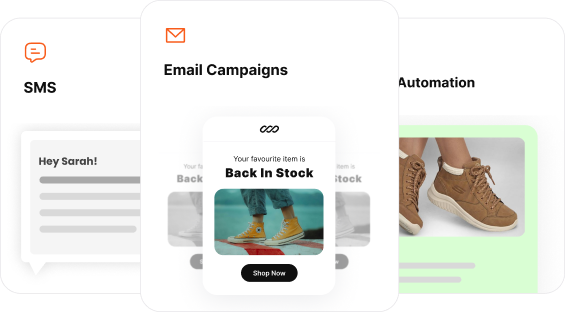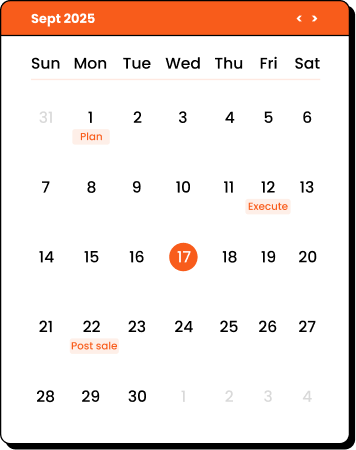Adopting omnichannel marketing for your business is a surefire formula for success. According to a study by Wisernotify, the purchase rate in omnichannel marketing is 250% higher than that of single-channel marketing. By shifting to omnichannel digital marketing, you increase your revenue potential, which neither single-channel nor multichannel marketing can match.
Customers now browse products across multiple platforms, whether it’s through an app, website, or other channels. As a business owner, it’s crucial to identify which channels your customers are using, integrate them, and ensure they work seamlessly together. This allows customers to browse products on one channel and complete their purchase on another.
If you are ready to take your business omnichannel, this guide will help you. Here, we’ll show you how to create a foolproof omnichannel marketing system that has the potential to drive millions, and possibly billions, in revenue.
Connect with your customers on WhatsApp using Retainful’s Omnichannel feature to achieve 98% open rates and maximize conversions.
What is Omnichannel Marketing?
Omnichannel marketing, by definition, is an approach that uses multiple integrated channels or platforms to deliver marketing messages to customers and provides a consistent experience.
The focus is on coordinating your marketing efforts across all marketing channels so that your customers receive targeted, relevant content at every stage of their purchase journey.
For example, when a customer visits your website, adds a product to their cart, but abandons it without making a purchase. If you have an omnichannel marketing system in place, the customers would receive messages through multiple channels such as email, WhatsApp, SMS, etc, asking them to complete the purchase whilst providing them with exciting offers.
Learn More: Shopping Cart Abandonment: Strategies + Examples
Which Channels are in Omnichannel Marketing?
Omnichannel marketing is not just limited to emails and WhatsApp but extends to multiple channels. Here’s an infographic that shows all the customer touchpoints.
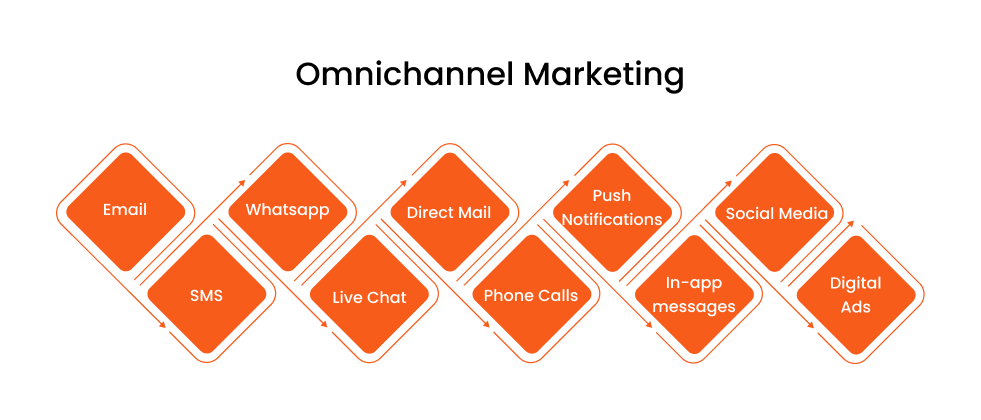
Types of Channels: Traditional vs Multichannel vs Cross-channel vs Omnichannel Marketing
Marketing channels often overlap with one another. For a layman, it might be confusing as to what is what, and how is how, and why all look the same. The 4 marketing channels are Omnichannel, multichannel, Cross-channel, and Traditional marketing.
Here’s a gist of what each channel is.
| Type of Marketing | Description |
| Traditional Marketing | Mostly offline and isolated, with limited interaction or personalization. |
| Cross-Channel Marketing | Connects some channels but doesn’t fully integrate them, often resulting in a fragmented experience. |
| Multi-Channel Marketing | Uses many channels but works in silos, without a cohesive customer experience. |
| Omnichannel Marketing | Integrates all channels, providing a seamless, consistent experience with full data sharing and personalization. |
The minute difference between them is shown in the table below.
| Factor | Traditional Marketing | Cross-Channel Marketing | Multi-Channel Marketing | Omnichannel Marketing |
| Channel Integration | None | Some | Separate | All Connected |
| Customer Experience | One-way | Mixed | Different | Smooth |
| Personalization | Low | Medium | Channel-based | High |
| Channel Types | Offline | Mix | Many | All |
| Data Sharing | No | Some | Not Shared | Shared |
| Goal | Awareness | Engage | Reach | Reach, Experience |
| Measurement | Hard | Some | Per Channel | All Channels |
| Automation | None | Little | Channel-Based | Fully Automated |
| Customer Journey | Straight | Jumpy | Broken | Continuous |
Why Should You Choose Omnichannel Marketing
Businesses that use 2 or more interconnected marketing channels (Omnichannel) to reach out to their customers enjoy a conversion rate of around 287%. This is way higher than what traditional and multi-channel marketing has offered.
In the marketing sales funnel, the decision stage is where customers make a purchase. Inconsistent and disconnected communication with customers has created a gap in conversion rates, resulting in less profit for businesses.
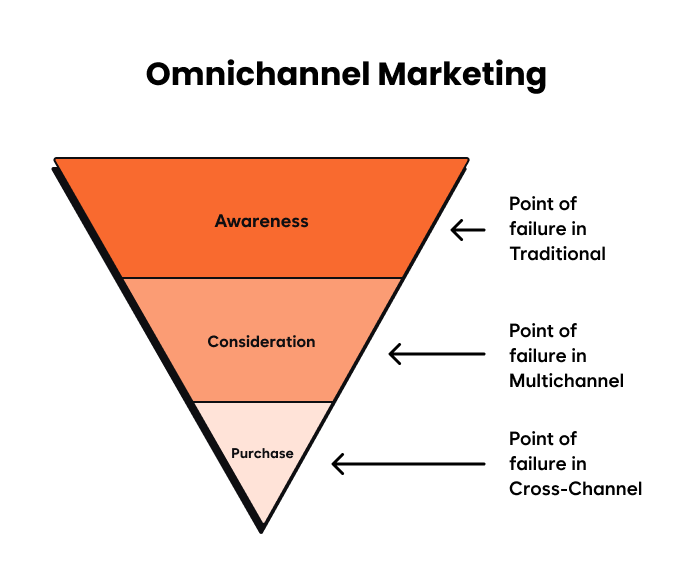
Omnichannel marketing exactly addresses that. It streamlines all your marketing channels with a more customer-centric approach. Besides conversion rates, it improves lead generation, customer acquisition, customer lifetime value, and customer retention.
- Integration Across Channels: Omnichannel marketing ensures all channels (emails, social media, mobile app, etc) are interconnected and work together.
- Consistent Messaging: Customers receive the same message across every channel regardless of where they engage.
- Personalized Customer Experience: Data collection becomes seamless. Omnichannel marketing uses data from all channels and provides customers with a personalized experience.
- Real-Time Data Sharing: With shared customer data between all channels, businesses can have a complete view of the customer and can engage them at the right time with the right offers.
- Timely Follow-Ups: Omnichannel marketing uses automation to send timely follow-ups, ensuring customers receive relevant content and offers at each stage of their purchase journey. (such as cart abandonment emails or post-purchase engagement)
Learn More: 10 Marketing Automation Workflow Examples (+Flow Charts)
- Reduced Customer Friction: Omnichannel marketing reduces inconsistent or disconnected touchpoints, resulting in a more fluid customer journey.
- Increased Customer Retention: With integrated customer service, customers can reach out through multiple channels (live chat, social media, email, etc.), providing them with quicker support and cultivating customer loyalty.
- Better Insights and Analytics: With omnichannel marketing tools like Retainful, you can get comprehensive insights from all customer interactions across various touchpoints. This helps you make data-driven decisions and optimize your marketing strategies.
Integrate your SMS, WhatsApp, and Email campaigns with Retainful’s omnichannel feature to deliver consistent messaging across all platforms.
How Does Omnichannel Marketing Work?
So far, we’ve talked about what Omnichannel marketing does to your business outcomes. But to implement it in your business, you must understand how it works. Here’s an infographic of its workflow.
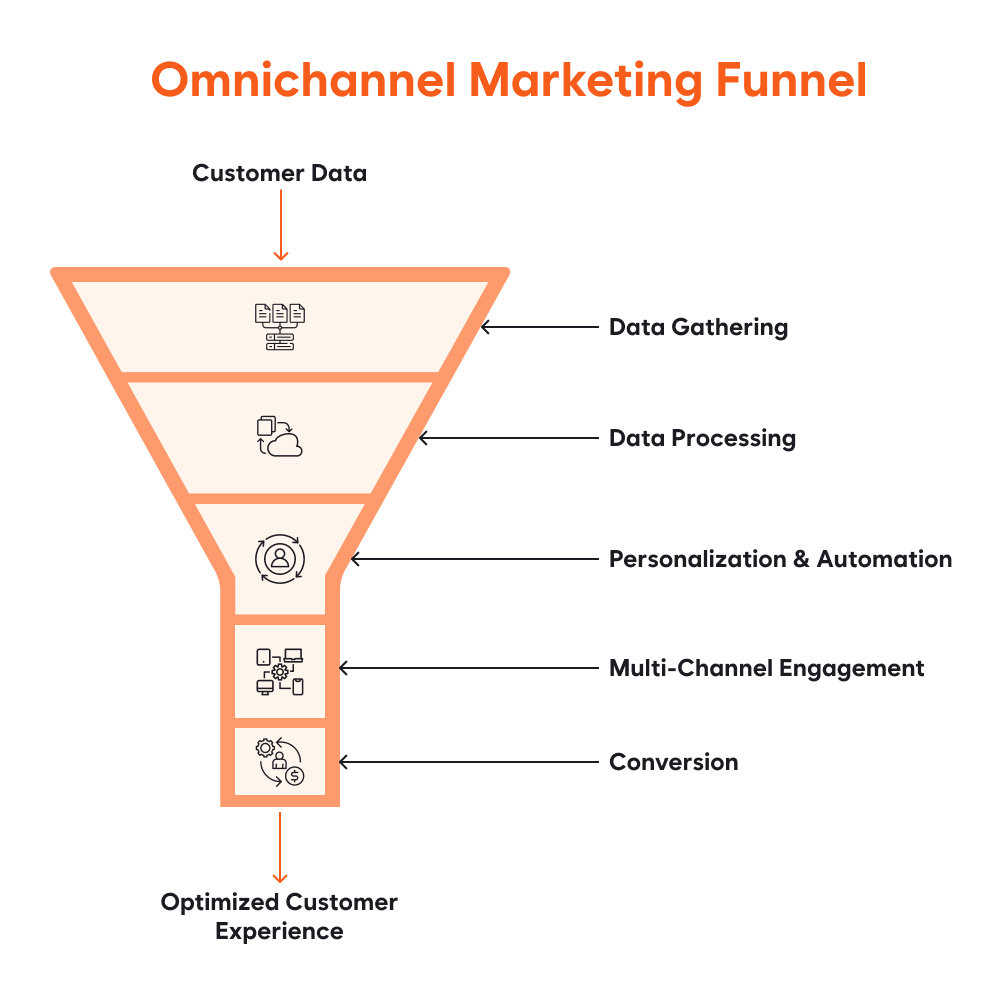
Let me elaborate on this entire funnel with an example scenario. A customer, let’s call her Jane, visits an eCommerce clothing store, browses a few products, adds an item to the cart, but leaves without making a purchase.
Later, she receives an email reminding her about the abandoned cart, follows up with an SMS offering a discount, and makes her complete the purchase. Let us break this down step-by-step.
- Data Gathering: When Jane browses a clothing item and adds it to her cart, the website tracks her interest in that and saves her cart details. Besides these, her email, location, etc, are stored after she signs up for an account.
- Data Processing: Jane’s data is integrated into the CRM system to create a 360-degree profile. She is then segmented as “Cart Abandoner” and tagged with preferences like “interested in jackets’ and ‘discount-sensitive.”
- Personalization & Automation: This one’s the deal breaker. A personalized email is automatically triggered to remind Jane of the jacket she left in her cart, along with an SMS follow-up offering her a 10% discount.
- Multi-channel Engagement: If she clicks the email or SMS link, she gets redirected to the website to complete the purchase. Otherwise, she’ll get targeted on social media with an ad, reinforcing her interest.
- Customer Action (Conversion): If Jane finds your product worthy, she’ll purchase it, through any channel she wants to, whilst applying that discount.
- Feedback & Optimization: Once Jane makes the purchase, she’ll receive a thank you email with a receipt. Now, the marketers will review the data from Jane’s customer journey and will make adjustments to the campaign for future customers.
Learn More: 10 Best eCommerce Thank You Email Templates and Tips
12 Key Infrastructure Elements for Omnichannel Marketing Platform
Before starting your omnichannel marketing, you need to ensure the infrastructure is in place to manage customer data, integrate systems, and provide a unified experience. Here are the 12 key elements that you must have.
| S/N | Infrastructure Element | Description |
| 1 | Customer Data Platform (CDP) | Centralizes and unifies customer data from all touchpoints (website, email, social media) to create a 360-degree view of the customer. |
| 2 | CRM System | Manages customer relationships and interactions, helping you to personalize messaging and track customer journeys. |
| 3 | Integrated Marketing Platform | Connects email marketing, social media, and customer service for seamless coordination. |
| 4 | Omnichannel Analytics Tools | Measures and tracks performance across all channels, using tools like Google Analytics to gain insights into customer behavior. |
| 5 | Automation Tools | Automate tasks like cart abandonment emails, follow-up emails, and lead nurturing across channels using platforms like Retainful. |
| 6 | E-commerce Platform with API Integration | Use a flexible eCommerce platform (e.g., Shopify, Magento) with API integrations to connect online and offline systems (inventory, payments, etc.). |
| 7 | Inventory Management System | Syncs inventories across all touchpoints (website, mobile, in-store) to prevent overselling and improve stock visibility. |
| 8 | Social Media Management Tools | To manage social media interactions and ensure messaging consistency across all platforms. |
| 9 | Unified Communication Channels | Integrate customer support tools to ensure a seamless communication experience across email, chat, and social media. |
| 10 | Payment Gateway Integration | Ensures consistent payment processes across all platforms (website, mobile, in-store), integrating with systems like Stripe and PayPal. |
| 11 | Cross-Channel Support Systems | Provide continuous customer support through live chat, email, and social media. |
| 12 | Abandoned Cart Recovery Tools | Sends automatic cart recovery emails and SMS reminders, helping you recover abandoned carts and retain customers through personalized offers. |
How to Build an Omnichannel Marketing Strategy for Your Business
If you are just starting out, the following points will help you build an omnichannel marketing strategy for your business.
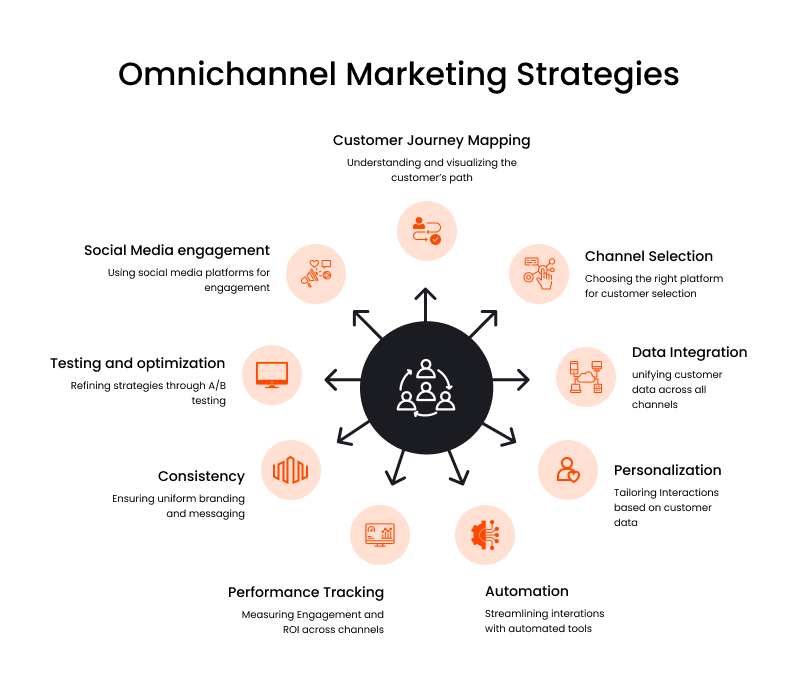
1. Understand Customer Journey
First, you need to identify the key stages of your customer buying journey, such as awareness, consideration, purchase, and post-purchase. Then, recognize how customers interact with your brand across various channels (Social Media, Website, etc).
2. Choose the Right Marketing Channel
Select the most relevant channel where your customers are most active. This includes online as well as offline channels. To ensure variety, you can consider combining several channels to cater to a wide range of customers.
3. Integrate Customer Data Across Channels
Use a CRM(Customer Relationship Management) or CDP(Customer Data Platform) to collect and store data from all channels in one place. Then, track customer behavior to get a 360-degrere customer view.
4. Personalize Customer Interactions
With the data collected, create personalized offers and content across all channels. Ensure the messages you send are consistent across all channels, providing a seamless experience.
5. Use Automation Tools
Set up automated workflows for common customer actions such as cart abandonment, welcome emails, or follow-up offers. With email marketing tools like Retainful, you can easily send targeted emails that get triggered when customers show interest or abandon their cart.
6. Implement Cross-Channel Tracking & Analytics
Email marketing tools like Retainful themselves can measure how your customers are interacting with your brand across channels. You can easily track engagement, conversion rates, retention rates, and ROI to assess the success of your omnichannel digital marketing efforts.
7. Maintain Consistency Across Touchpoints
Ensure your customers have a consistent experience, whether they are interacting with your website, emails, etc.
8. Test and Optimize
Run A/B tests with different messages, offers, and strategies across marketing channels to see what works with your audience. With these insights, you can refine your approach to improve the customer experience and conversions.
9. Leverage Social Media & Customer Support
Use platforms like Facebook, Instagram, etc, to engage customers in real-time. You can also integrate customer service channels like Live chat or Chatbots that can work across websites, mobile apps, or social media.
Above all, omnichannel marketing is about constantly evolving and staying updated on new tools, customer expectations, and emerging platforms.
Successful Examples of Omnichannel Marketing
Here are 3 examples that explain how top brands used omnichannel marketing to create a domino effect, where one channel directly influenced customer behavior and led to purchase across multiple touchpoints.
a) Starbucks: App Drives Loyalty and Repeat Purchases
The Starbucks app drives repeat purchases, increasing both customer retention and sales because the experience is convenient and personalized.
How it Worked:
- Step 1: A customer uses the Starbucks mobile app to check their reward points and sees a personalized offer for a free drink based on their past purchases.
- Step 2: This offer encourages the customer to order ahead on the app, saving time when they pick up their coffee at the store.
- Step 3: Now, customers enjoy a hassle-free experience. The next time they visit, the app sends a push notification reminding them of a new offer or loyalty points, thus making them use the app.
b) Nike: Social Media Ads Leading to Personalization in App
Nike offers a seamless experience between its website, social media ads, and app leads to higher conversions and increased sales.
How it Worked:
Step 1: A customer browsing for running shoes on Nike’s website sees a targeted ad on Instagram about a new product they were looking at. The ad includes a discount code.
Step 2: The customer clicks on the ad and is taken to the Nike app for an exclusive discount, where they can customize the product and check out in a few steps.
Step 3: After purchasing, the Nike app suggests personalized workout plans and shows the customer more products based on their preferences.
c) Walmart: Email Reminders Leading to In-Store Pickup
Email reminders and its in-store pickup process drove customers back to the store, resulting in purchases. This cross-channel interaction led to an increase in sales conversions from abandoned carts.
How it Worked:
- Step 1: A customer starts their shopping journey on Walmart’s website, adds products to their cart, by leaves without purchasing (Abandoned Cart).
- Step 2: Now, Walmart sends an email reminder with a special discount code for the abandoned items, reminding the customer they can pick up in-store.
- Step 3: The customer visits their local Walmart store, picks up the item, and while in-store, sees more personalized offers for related items on their mobile app, completing the purchase.
These major brands have used omnichannel marketing in some way that has given them success. If you are someone aspiring to make your brand known or make millions of dollars out of it, take it omnichannel.
Benefits of Omnichannel Marketing
Omnichannel marketing offers several key benefits that can improve the customer experience, increase sales, and accelerate your business growth. Some of the most important benefits are listed below.
- Seamless Customer Experience: Omnichannel marketing ensures a consistent experience across all touchpoints (website, social media, in-store), making interactions smooth and uninterrupted.
- Increased Customer Engagement: Engages customers across multiple channels, thus keeping your brand top-of-mind and increasing opportunities for conversions.
- Improved Customer Loyalty: Provides a personalized experience to your customers using their data, resulting in higher satisfaction and long-term loyalty.
- Higher Conversion Rates: Offers customers multiple ways to purchase products, such as online, in-store, mobile apps, etc, increasing the likelihood of conversions.
- Better Data Insights: Data integration can be done from all channels, giving a 360-degree view of customer behavior and allowing for more targeted omnichannel marketing campaigns.
- Increased Sales Opportunities: More touchpoints, more sales opportunities. Having mobile apps, social media, etc, improves conversion rates.
- Competitive Advantage: Having omnichannel marketing in your arsenal is a great differentiator that separates your brand from your competitors with a more customer-focused approach.
- Brand Consistency: Having an interconnected marketing system helps you maintain consistent messaging and branding across channels, thus increasing your trust.
- Improved Marketing Efficiency: Omnichannel marketing is a sureshot way to reduce your marketing costs and improve your overall marketing ROI.
Recover more abandoned carts by sending reminders via Email, followed by SMS, and a final WhatsApp nudge to complete the purchase.
The Big Picture
If you’re planning to embrace omnichannel marketing, be prepared for ongoing evolution. As new marketing channels emerge, you’ll need to integrate hyper-personalization, AI, and advanced automation into your strategy.
Additionally, leveraging predictive analytics and machine learning will allow you to anticipate your customers’ needs, making interactions more interactive and intuitive.
In the future, many brands will adopt omnichannel marketing and lead with innovation. To ensure your brand doesn’t fall behind, it’s crucial to implement omnichannel marketing now, especially with the right tools like Retainful. This will position you for success and help you become a major player in your industry.
Also Read:
- AI Email Marketing: How to Boost Your Campaigns with AI
- Retention Marketing: Strategies + Examples (2025)
Frequently Asked Questions
The 4 pillars of omnichannel marketing are customer-centricity, integrated technology, consistent messaging, and data-driven insights. These pillars reflect how omnichannel marketing strategies have evolved to meet changing customer expectations across channels.
There are many omnichannel marketing examples, and one is an e-commerce brand sending a cart reminder via email, a follow-up SMS, and a WhatsApp nudge—creating a seamless buying experience across channels.
Customer interaction is central to omnichannel marketing, as it creates consistent engagement across various touchpoints. Omnichannel marketing statistics indicate that businesses with strong cross-channel interaction see higher customer retention and sales.
Popular omnichannel marketing tools include platforms like Retainful, HubSpot, and Klaviyo. These omnichannel marketing services help brands automate communication across email, SMS, WhatsApp, and more.
Omnichannel marketing is often better for customer experience as it integrates channels for seamless interaction. The difference between multichannel and omnichannel marketing lies in integration—omnichannel connects the channels, multichannel doesn’t.
In marketing, omnichannel means delivering a unified customer experience across all platforms—online, offline, and mobile—so interactions feel connected and consistent.
Disjointed customer communication is not included in omnichannel marketing. It focuses on seamless integration, so siloed or inconsistent messaging doesn’t align with its core approach.
In 2025, key trends include AI-driven personalization, predictive analytics, and advanced omnichannel marketing automation enabling real-time, contextual messaging across every touchpoint.
Though ‘Sales’ is the ultimate factor, there are certain other equally important metrics that determine the success of your omnichannel marketing efforts. They are conversion rates, customer retention, and engagement across channels. Tools like attribution models and CLV also help you assess how effectively your channels work together.

